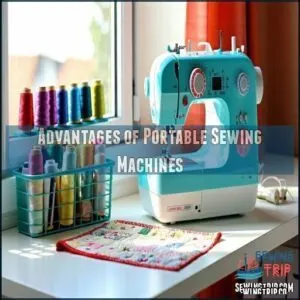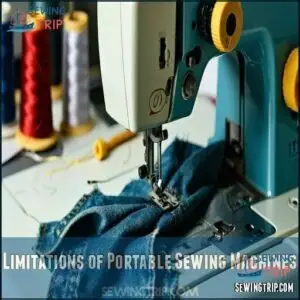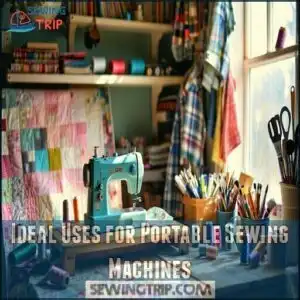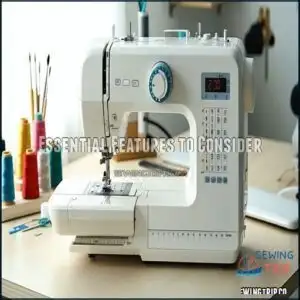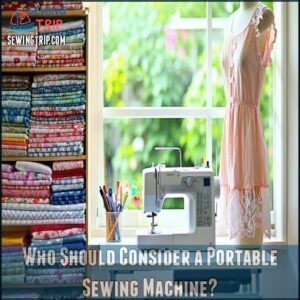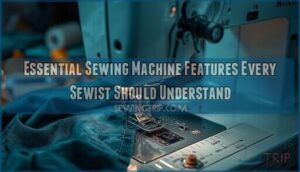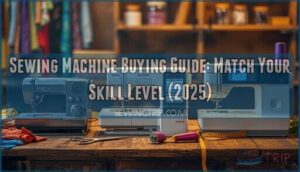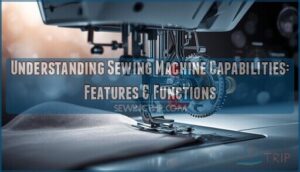This site is supported by our readers. We may earn a commission, at no cost to you, if you purchase through links.
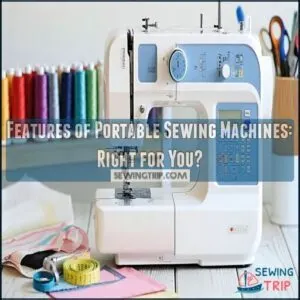
They’re perfect if you’re tight on space or need to sew in different locations.
Most offer essential stitches, automatic threading, and LED lighting at a budget-friendly price ($60-200).
However, they won’t handle heavy denim or quilting as effectively as their full-sized cousins.
Think of them as the Swiss Army knife of sewing—versatile enough for basic projects but with limitations.
Your perfect machine match depends on your specific sewing habits and where your creative journey will take you.
Table Of Contents
- Key Takeaways
- Understanding Portable Sewing Machines
- Advantages of Portable Sewing Machines
- Limitations of Portable Sewing Machines
- Ideal Uses for Portable Sewing Machines
- Choosing The Right Portable Sewing Machine
- Comparing Portable and Full-Size Sewing Machines
- Who Should Consider a Portable Sewing Machine?
- Frequently Asked Questions (FAQs)
- Conclusion
Key Takeaways
- You’ll get essential functionality in a compact package with portable sewing machines, offering basic stitches, automatic threading, and LED lighting at budget-friendly prices ($60-200).
- Your space constraints won’t limit your creativity as these machines excel in small apartments, during travel, and for crafters who need to sew in different locations.
- You’ll face limitations with portable models as they typically offer slower sewing speeds, smaller work areas, and can’t effectively handle heavy fabrics like denim or complex projects.
- You’re the ideal candidate for a portable machine if you’re an occasional mender, space-constrained crafter, or traveling seamstress who prioritizes convenience over advanced capabilities.
Understanding Portable Sewing Machines
When considering a portable sewing machine, you’re looking for convenience and ease.
These mini sewing machines offer portability, perfect for small projects and repairs.
With their lightweight design, you can take them anywhere, making them ideal for travel or small spaces, embodying the concept of machine definition and sewing machine portability.
I’ll create a short, engaging blockquote that captures the essence of portable sewing machines in the same tone as the content:
Pack creativity in your pocket—portable sewing machines bring stitch magic wherever life takes you.
Advantages of Portable Sewing Machines
You’re considering a portable sewing machine, and this is a key factor to consider.
Portable sewing machines offer you compact size, easy storage, and affordability, making them a great option for small projects and on-the-go sewing.
Compact Size and Lightweight Design
You’ll love a portable sewing machine’s compact size and lightweight design.
It offers
- Storage Solutions
- Travel Convenience
- Ergonomic Benefits, making it perfect for space efficiency and portability impact.
This mini sewing machine is a great choice, providing a compact size and lightweight design for ease of use, and has a significant portability impact.
Easy Storage and Transportation
Now, let’s talk about easy storage and transportation.
Got a small space? No problem! A portable sewing machine is your friend.
Its lightweight design means you can stash it easily. Think closets, or even under the bed.
Compact cases and storage solutions make mobile crafting a breeze.
Grab your travel sewing machine, and you’re set! Enjoy travel sewing with your mini sewing machine or small sewing machine.
Affordability
You’ll appreciate the affordability of portable sewing machines, offering a great value proposition.
With a lower sewing machine price, they provide long-term savings and a good investment return.
Budget sewing just got easier, as portable sewing machine cost is unbeatable, making them perfect for beginners or light users on a budget.
These machines also excel at various sewing tasks, such as repairs and crafts.
User-Friendly Features
You’ll enjoy user-friendly features like automatic threading and tension control.
Simple controls and LED lighting make sewing easy. Many machines offer stitch selection and a free arm design, simplifying tricky areas.
These features create an easy sewing machine, perfect for beginners, making sewing a breeze with automatic threading.
Limitations of Portable Sewing Machines
You’re considering a portable sewing machine, but it’s vital to know their limitations.
They may not be suitable for heavy fabrics or complex projects, so you’ll want to weigh their restrictions.
Like slower sewing speeds and smaller sewing areas, before making a decision.
Restricted Capabilities
You’ll find that portable sewing machines have restricted capabilities.
They struggle with heavy fabrics and complex projects, which can lead to machine overload.
Fabric limitations and sewing complexity are key concerns.
When evaluating a portable sewing machine, consider its durability concerns, feature omission, and speed constraints to guarantee it meets your needs, avoiding project complexity that may be too much for its capabilities.
Slower Sewing Speed
You’ll notice a slower sewing speed with a portable sewing machine.
This affects project completion time, but mastering speed control boosts efficiency.
Motor power impact and stitch quality tradeoff are key considerations, as user skill influence can mitigate slower sewing speed, a notable portable machine benefit.
Smaller Sewing Area
You’ll encounter project limitations with a portable sewing machine’s small sewing area.
Small sewing areas on portable machines challenge creativity but encourage innovative solutions for compact crafting spaces!
This affects fabric manipulation and complex seams.
Consider workspace ergonomics and creative adaptations to maximize your space, making the most of your portable sewing machine’s features.
Limited Fabric Handling
You’ll face fabric limitations with a portable sewing machine, particularly with heavy fabrics like denim or leather, due to material thickness and limited fabric handling.
This makes it less suitable for heavy fabrics, and more ideal for lightweight sewing projects, highlighting the denim dilemma and leather challenges.
Ideal Uses for Portable Sewing Machines
You’re considering a portable sewing machine, and now you’re wondering what you can use it for.
Portable sewing machines are ideal for you if you plan to work on small projects, repairs, and crafting, or if you need a machine that’s easy to take on the go.
Small Projects and Repairs
You can tackle small projects and repairs with a portable sewing machine. It’s perfect for quick alterations, mending clothes, and DIY crafts using fabric scraps.
As a beginner, you’ll find it easy to handle small projects and make quick repairs. A small sewing machine is great for on-the-go mending, allowing you to stay in control and save time.
It’s ideal for beginner projects, offering precision and ease of use. With a portable sewing machine, you can make quick repairs and alterations effortlessly, making it a must-have for small sewing tasks.
Crafting and Hobbies
You can express your creativity with a portable sewing machine, exploring DIY projects, quilting ideas, and fabric crafts.
It’s perfect for sewing patterns, creative embellishments, and more.
Your mini sewing machine offers convenience, allowing you to work on various projects anywhere, making it ideal for crafting and hobbies, and bringing your ideas to life with ease.
These machines are even great for quick repairs on the go, providing an opportunity for quick fixes.
Travel and On-the-Go Sewing
Take your creativity along with you by packing a portable sewing machine in your travel bag. You’ll never miss a chance to stitch up an unexpected tear or work on small projects away from home.
Your travel sewing kit essentials should include:
- A lightweight machine (under 7 lbs) with built-in lighting
- Basic supplies like pre-wound bobbins and travel scissors
- A protective case that meets airline sewing restrictions
Don’t worry about on-the-go alterations—today’s travel sewing machines offer jam-resistant features and simple controls that work perfectly on hotel desks or kitchen tables. These are available as a specialized travel option.
Choosing The Right Portable Sewing Machine
You’ll need to match your specific sewing needs with the right portable machine features, considering factors like stitch variety, automatic threading, and your budget constraints.
Just like finding the perfect pair of shoes, selecting a machine that fits your sewing style will save you from the frustration of trying to hem jeans with a mini-stitcher that can’t handle denim, which is a key consideration for your budget constraints.
Essential Features to Consider
When shopping for a portable sewing machine, focusing on essential features saves you headaches down the road.
Your ideal machine should balance weight and functionality without sacrificing performance.
- Needle Threader: Automatic threading systems spare aging eyes from squinting at tiny needle holes
- Speed Control: Adjustable settings let you slow down for precision work or speed up for straight seams
- Stitch Variety: 10-15 basic stitches cover most needs; don’t pay extra for decorative options you’ll rarely use
Frame material affects durability, while machine weight matters for true portability.
Consider browsing a site for a suitable sewing product before deciding.
Remember, the best sewing machine features match your specific travel and project needs.
Matching Your Sewing Needs
When selecting a portable sewing machine, your specific sewing needs should drive your decision.
Consider your typical project complexity—will you be hemming pants or crafting intricate quilts?
Different fabric types require varying machine capabilities; lightweight cotton needs less power than denim or leather.
Your skill level matters too—beginners might prioritize user-friendly features while experienced sewists need more specialized functions.
Think about your usage frequency—occasional menders need less durability than daily users.
Feature prioritization helps narrow choices; do you need multiple stitch options or is basic functionality enough?
Some models even offer adjustable speed options for different projects.
The right portable machine benefits your specific sewing tasks, enhancing convenience without unnecessary complications.
Budget Considerations
Now that you’ve matched your sewing needs, let’s talk money. Your budget isn’t just about the initial price tag—it’s about smart planning.
Entry-level models start around $50, while feature-rich options can reach $500+. Consider the feature tradeoffs: that $20 handheld machine might seem like a steal until you realize it can’t handle your denim projects.
Brand comparisons show Brother XM2701 and Singer Tradition 2250 offer excellent budget options without sacrificing quality. For a variety of options, consider a portable sewing budget.
Remember to factor in long-term costs like extra presser feet and maintenance. Sometimes spending a bit more upfront means better durability and fewer repair costs down the road. Think of your sewing machine budget as an investment—the cheapest option isn’t always the most affordable in the long run.
Comparing Portable and Full-Size Sewing Machines
Choosing between portable and full-size sewing machines is like deciding between a compact car and an SUV.
While full-size machines offer greater sewing power and stitch options for complex projects, portable machines win on convenience and space efficiency.
Full-size models typically provide better machine durability and can handle thicker fabrics, but their user experience requires more setup space.
Portable sewing machines are ideal for beginners and those with limited space, though they might lack the robust features of their larger counterparts.
Your decision should balance your project complexity needs with practical considerations like storage and transportation.
Many users appreciate their lightweight and compact design, making them easy to store and carry.
Who Should Consider a Portable Sewing Machine?
You’ll benefit from a portable sewing machine if you’re short on space, travel frequently, or only need occasional mending capabilities without the commitment of a full-sized model.
These compact workhorses offer enough functionality for most basic projects while taking up less room than that bread maker you’ve used exactly once since last Christmas.
Space-Constrained Crafters
Within the confines of your tiny studio or apartment, a portable sewing machine becomes your creative ally.
They’re designed specifically for space-constrained crafters who need flexibility without sacrificing functionality. You’ll appreciate how these compact machines tuck neatly into closet storage when not in use, making minimalist crafting possible regardless of square footage.
From fold-away tables to under-bed storage solutions, mobile crafting has never been more accessible. If your sewing dreams are bigger than your space, mini sewing machines offer the perfect balance of capability and convenience.
Traveling Seamstresses
As a space-constrained crafter, you’ve mastered working in tight quarters.
Now let’s talk about how portable sewing machines open up possibilities for those with wanderlust.
Traveling seamstresses can’t afford to leave their creativity at home. A lightweight sewing machine for travel lets you stitch wherever inspiration strikes.
You won’t miss a beat when attending sewing retreats or creative workshops across the globe.
Here’s why portable sewing machines are perfect travel companions:
- Compact design – Fits easily in carry-on luggage or car trunks
- Quick setup – No complicated assembly required at your destination
- Mobile tailoring – Offer repair services while traveling
- Fabric sourcing – Create with unique materials found during your journeys
- Community connection – Join sewing circles anywhere you go
Occasional Menders
For the occasional mender, a portable sewing machine offers just the right balance of function without the commitment to a full-sized model. You don’t need professional skills to tackle basic sewing tasks with these lightweight helpers.
Keep these simple repairs at your fingertips:
- Mending clothes with torn seams in minutes
- Hemming pants or skirts for quick alterations
- Reattaching buttons that constantly play hide-and-seek
- Adding patches to extend the life of favorite jeans
- Fixing broken zippers without breaking a sweat
A mini sewing machine saves you from the "emergency tailor run" and fits neatly in your closet between uses—perfect for sewing on the go.
Frequently Asked Questions (FAQs)
What are the disadvantages of a portable sewing machine?
Like a butterfly with clipped wings, your portable sewing machine can’t handle heavy fabrics.
It offers limited workspace for complex projects, sews slower than full-sized models.
It typically lacks advanced features you’d find in industrial machines.
Which sewing machine has the least problems?
Janome and Brother models consistently have the least problems.
You’ll find their heavy-duty metal frames and jam-resistant features keep headaches at bay.
For portable options, the Brother XM2701 is your reliable go-to workhorse.
What is the lifespan of a portable sewing machine?
Martha’s portable sewing machine from the 1990s still purrs like a kitten.
With proper maintenance, your portable sewing machine can last 5-25 years.
Regular cleaning, oiling, and yearly tune-ups will dramatically extend its lifespan.
However, remember that machine maintenance substantially influences longevity.
Are handheld sewing machines useful?
Handheld sewing machines can be useful for quick repairs on the go.
They’re limited to simple fixes and lightweight fabrics, but you’ll appreciate their convenience when you need emergency hemming or small mending jobs.
Is a portable sewing machine worth it?
Portable sewing machines are worth it if you’re short on space, travel often, or need quick repairs.
They’re affordable and user-friendly, though they can’t handle heavy fabrics like their full-sized counterparts.
What are the cons of mini sewing machines?
With 75% less power than standard machines, mini sewing machines struggle with thick fabrics.
You’ll also face limited workspace, fewer stitch options, and slower speeds, making complex projects challenging despite their portable convenience.
How useful is a mini sewing machine?
Mini sewing machines are perfect for quick repairs, small projects, and beginners.
They offer portability and a space-saving design, which makes them ideal for certain users.
However, they won’t handle heavy fabrics or complex projects like their full-sized counterparts.
What features should I look for in a sewing machine?
Like finding the perfect dance partner, you’ll want automatic threading, adjustable tension control, and built-in stitch variety.
Don’t forget LED lighting and speed control to make your sewing journey smooth and enjoyable.
Can portable sewing machines handle embroidery or quilting?
Some portable machines can handle basic embroidery and light quilting, but you’ll face limitations with workspace and power.
They’re great for small projects but won’t replace specialized machines for advanced work.
Are spare parts readily available for portable machines?
You’ll find spare parts for most portable machines easily online and at sewing shops.
Manufacturers like Singer, Brother, and Janome keep components well-stocked, though older or discontinued models might require specialized searches.
Conclusion
Ultimately, understanding the features of portable sewing machines helps determine if they’re right for you.
They deliver convenience, simplicity, and affordability—perfect companions for basic projects and tight spaces.
You’ll appreciate their versatility when making quick repairs or crafting on vacation.
While they won’t replace industrial machines, they’ll serve you well for everyday tasks.
Consider your sewing goals, available space, and mobility needs before investing.
The right portable machine might be just the practical solution you’ve been searching for.
- https://www.toptenreviews.com/sewing-machines-brother-cs-review
- https://www.techgearlab.com/reviews/electronics/sewing-machine/singer-simple-3232
- https://sewingfromhome.com/brother-xm2701-sewing-machine-review-best-for-beginners/
- https://www.jaxpety.com/blog/how-long-do-sewing-machines-last
- https://www.reddit.com/r/SewingForBeginners/comments/1fo4dx7/is_it_worth_it_to_try_portable_sewing_machines/


